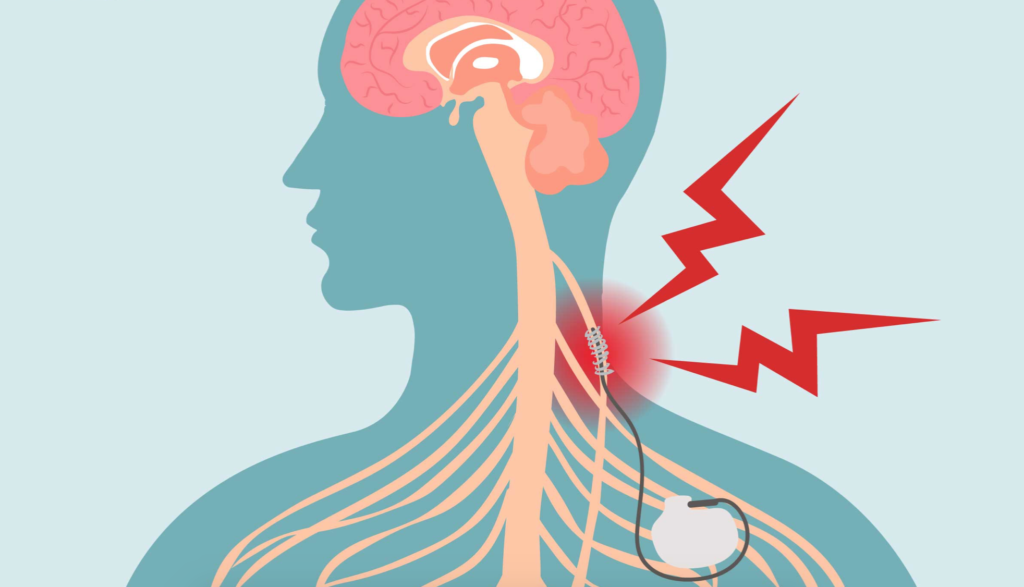NEUROMODULATION

What’s Neuromodulation?
Neuromodulation refers to a form of technology that acts directly on nerves fibers. It involves the alternation, modification or modulation of nerve activity by delivering electrical or pharmaceutical agents directly to specific neurological sites in the body. It aims to normalize – or – modulate nervous tissue function.
Neuromodulation, a life changing therapy, can involve a variety of electromagnetic stimuli such as magnetic field (Repetitive transcranial magnetic stimulation, rTMS), an electric current, or a drug delivered directly into the subdural space (intrathecal drug delivery). Recent applications of neuromodulation involve targeted introduction of genes or gene regulators and light (optogenetics). Neuromodulation, whether electrical or magnetic, makes use of the body’s biological response by stimulating nerve cell activity that can influence a large number of nerves by releasing neurotransmitters. These include neurotransmitters such as dopamine, or other chemical messengers such as the peptide Substance P, that can modulate the excitability and firing patterns of neural circuits.
This method may also have electrophysiological effects on axonal membranes (axolemma) as the mechanism of action of electrical interaction with neural elements. The end effect involves the “normalization” of a neural network function from its perturbed state. Presumed mechanisms of action for neurostimulation include depolarizing blockade, stochastic normalization of neural firing, axonal blockade, reduction of neural firing keratosis, and suppression of neural network oscillations. Although the exact mechanisms of neurostimulation remain unknown, the empirical effectiveness has led to considerable clinical applications.
Treatments existing and emerging from neuromodulation also include application in medication-resistant epilepsy, chronic headache conditions, and functional therapy ranging from urinary and digestive or respiratory control to improvement of sensory deficits, such as hearing (cochlear implants and auditory brainstem implants) and vision (retinal implants). Technical improvements include a trend toward minimally invasive (or non-invasive) systems; as well as smaller, more sophisticated devices that may have automated feedback control, and conditional compatibility with magnetic resonance imaging (MRI). Scientists have carried out investigations as regards neuromodulation therapy for other chronic conditions such as Parkinson’s disease, Alzheimer’s disease, depression, chronic pain, and also as a complementary treatment in recovery from stroke.
Methods of Neuromodulation
- Invasive electrical neuromodulation method
This method involves an operation that requires positioning an electrode. It may also involve implanting the stimulator, with the battery (similar to a pacemaker), or these structures may remain outside the body. Generally, neuromodulation systems deliver electrical currents and typically consist of the following components: an epidural, subdural or parenchymal electrode placed via minimally invasive techniques or an open surgical exposure to the target (surgical “paddle” or “grid” electrodes), or stereotactic implants for the central nervous system, and an implanted pulse generator (IPG).
Forms of invasive neuromodulation therapy include:
- Spinal cord stimulation
- Deep brain stimulation
- Vagus nerve stimulation (VNS)
- Occipital nerve stimulation (ONS)
- Functional electrical stimulation (FES)
- Percutaneous tibial nerve stimulation (PTNS) for the treatment of incontinence.
- Sacral nerve stimulation (SNS)/ sacral neuromodulation (SNM)
- Peripheral nerve stimulation (PNS, which refers to the stimulation of nerves beyond the brain and spinal cord, and considered to include the occipital or sacral nerve stimulation)
- Auditory brainstem implant, which provides a sense of sound to a patient unable to utilize a cochlear implant due to a damaged or missing cochlea or auditory nerve
- Non-invasive electrical methods
These methods involve the use of external electrodes to apply electric current to the body with the aim of changing the functioning of the nervous system.
These methods include:
- Transcranial direct current stimulation (tDCS)
- Electroconvulsive therapy (ECT)
- Transcutaneous electrical nerve stimulation (TENS) and a prescription variant of TENS, transcutaneous afferent patterned stimulation (TAPS)
- Non-invasive magnetic methods
Magnetic methods of neuromodulation usually include non-invasive procedures. These require no surgery to allow a magnetic field to enter the body, due to the magnetic permeability of tissue shares similarity with that of air. Magnetic fields penetrate the body very easily. These methods include:
- Repetitive transcranial magnetic stimulation (rTMS)
- Transcranial pulsed electromagnetic fields (tPEMF)
- Invasive chemical methods
Chemical neuromodulation always involves invasive methods, due to the fact that delivery of a drug must occur in a highly specific location of the body. The non-invasive variant includes traditional pharmacotherapy, such as swallowing a tablet. Intrathecal drug delivery systems (ITDS), may deliver small doses of painkillers or anti-spasm medicine directly to the site of action.
References
https://www.neuromodulation.com/about-neuromodulation
Al-Otaibi FA, Hamani C, Lozano AM (October 2011). “Neuromodulation in epilepsy”. Neurosurgery. 69 (4): 957-79.
